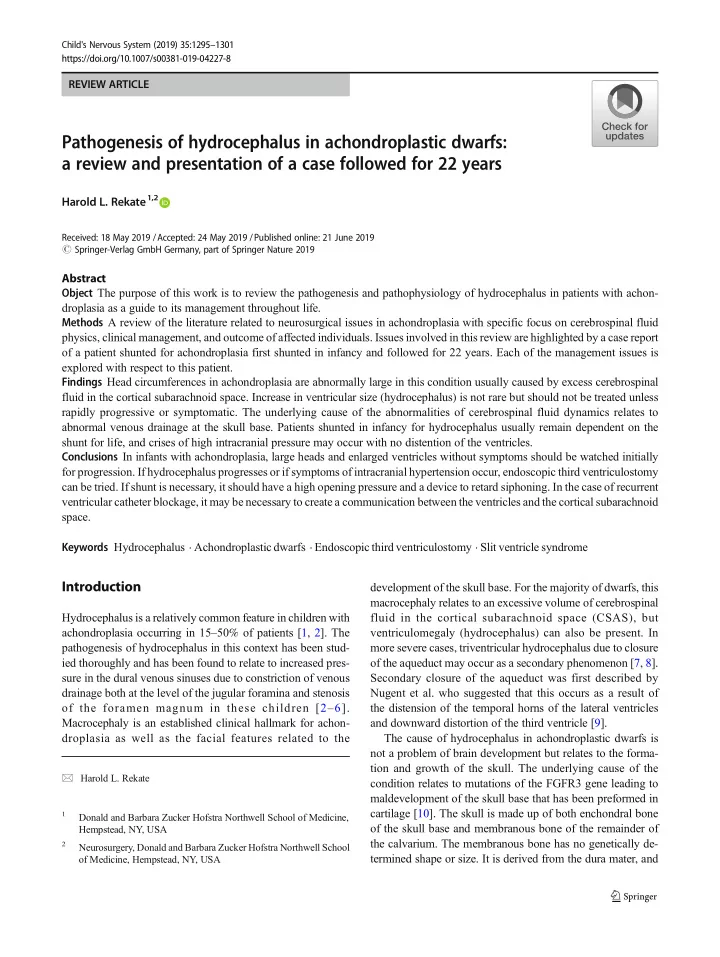

Child's Nervous System (2019) 35:1295 – 1301 https://doi.org/10.1007/s00381-019-04227-8 REVIEW ARTICLE Pathogenesis of hydrocephalus in achondroplastic dwarfs: a review and presentation of a case followed for 22 years Harold L. Rekate 1,2 Received: 18 May 2019 /Accepted: 24 May 2019 /Published online: 21 June 2019 # Springer-Verlag GmbH Germany, part of Springer Nature 2019 Abstract Object The purpose of this work is to review the pathogenesis and pathophysiology of hydrocephalus in patients with achon- droplasia as a guide to its management throughout life. Methods A review of the literature related to neurosurgical issues in achondroplasia with specific focus on cerebrospinal fluid physics, clinical management, and outcome of affected individuals. Issues involved in this review are highlighted by a case report of a patient shunted for achondroplasia first shunted in infancy and followed for 22 years. Each of the management issues is explored with respect to this patient. Findings Head circumferences in achondroplasia are abnormally large in this condition usually caused by excess cerebrospinal fluid in the cortical subarachnoid space. Increase in ventricular size (hydrocephalus) is not rare but should not be treated unless rapidly progressive or symptomatic. The underlying cause of the abnormalities of cerebrospinal fluid dynamics relates to abnormal venous drainage at the skull base. Patients shunted in infancy for hydrocephalus usually remain dependent on the shunt for life, and crises of high intracranial pressure may occur with no distention of the ventricles. Conclusions In infants with achondroplasia, large heads and enlarged ventricles without symptoms should be watched initially for progression. If hydrocephalus progresses or if symptoms of intracranial hypertension occur, endoscopic third ventriculostomy can be tried. If shunt is necessary, it should have a high opening pressure and a device to retard siphoning. In the case of recurrent ventricular catheter blockage, it may be necessary to create a communication between the ventricles and the cortical subarachnoid space. Keywords Hydrocephalus . Achondroplastic dwarfs . Endoscopic third ventriculostomy . Slit ventricle syndrome Introduction development of the skull base. For the majority of dwarfs, this macrocephaly relates to an excessive volume of cerebrospinal Hydrocephalus is a relatively common feature in children with fluid in the cortical subarachnoid space (CSAS), but achondroplasia occurring in 15 – 50% of patients [1, 2]. The ventriculomegaly (hydrocephalus) can also be present. In pathogenesis of hydrocephalus in this context has been stud- more severe cases, triventricular hydrocephalus due to closure ied thoroughly and has been found to relate to increased pres- of the aqueduct may occur as a secondary phenomenon [7, 8]. sure in the dural venous sinuses due to constriction of venous Secondary closure of the aqueduct was first described by drainage both at the level of the jugular foramina and stenosis Nugent et al. who suggested that this occurs as a result of of the foramen magnum in these children [2 – 6]. the distension of the temporal horns of the lateral ventricles Macrocephaly is an established clinical hallmark for achon- and downward distortion of the third ventricle [9]. droplasia as well as the facial features related to the The cause of hydrocephalus in achondroplastic dwarfs is not a problem of brain development but relates to the forma- tion and growth of the skull. The underlying cause of the * Harold L. Rekate condition relates to mutations of the FGFR3 gene leading to maldevelopment of the skull base that has been preformed in cartilage [10]. The skull is made up of both enchondral bone 1 Donald and Barbara Zucker Hofstra Northwell School of Medicine, of the skull base and membranous bone of the remainder of Hempstead, NY, USA the calvarium. The membranous bone has no genetically de- 2 Neurosurgery, Donald and Barbara Zucker Hofstra Northwell School termined shape or size. It is derived from the dura mater, and of Medicine, Hempstead, NY, USA
Recommend
More recommend